Adaptation and Psychometric Properties of a Romanian Version of Metacognitive Awareness Inventory for Teachers (RoMAIT)
Abstract
1. Introduction
1.1. Background of This Study
1.2. Measuring Metacognition in Education
- Subjectivity and social desirability bias;
- Poor relationship with the actual performance of the subjects;
- Limited replicability;
- Insufficient theoretical explanation of the factor choice and lack of comparison between different factor models;
- Inconsistencies in correlations with other measures of the same constructs and with related constructs.
1.3. Objectives
2. Method
2.1. Participants
2.2. Procedures
2.3. Preliminary Data Processing
3. Results
3.1. Item Analysis
3.2. Factor Analysis
4. Discussion
4.1. Related Work
4.2. Limitations
5. Conclusions
Author Contributions
Funding
Institutional Review Board Statement
Informed Consent Statement
Data Availability Statement
Conflicts of Interest
Appendix A
| Factor | Item | Item Text in Romanian for MAIT |
|---|---|---|
| DK | MAIT1 | Sunt constient(ă) de punctele mele tari si slabe ca profesor. |
| MAIT7 | Știu de ce competențe ai nevoie pentru a fi un bun profesor. | |
| MAIT13 | Dețin controlul asupra modului în care predau. | |
| MAIT19 | Stiu ce ar trebui să fac la clasă. | |
| PK | MAIT2 | Incerc să folosesc la clasă strategii despre care stiu că au funcționat în trecut. |
| MAIT8 | Am o motivație pentru fiecare din strategiile pe care le folosesc la clasă. | |
| MAIT14 | Sunt constient(ă) de strategiile pe care le folosesc atunci când sunt la clasă. | |
| MAIT20 | Aleg în mod automat strategiile care mă ajută la clasă. | |
| CK | MAIT3 | La clasă, îmi folosesc punctele tari ca să le compensez pe cele slabe. |
| MAIT9 | Mă pot motiva să continui munca la clasă atunci când e nevoie. | |
| MAIT15 | Folosesc strategii diverse în functie de situația cu care mă confrunt la clasă. | |
| MAIT21 | Știu când fiecare din strategiile pe care obișnuiesc să le folosesc va fi cea mai eficienta | |
| P | MAIT4 | Imi organizez timpul la clasă cat mai eficient, în așa fel încât să reușesc să mă încadrez în timp. |
| MAIT10 | Înainte de a începe să predau îmi fixez obiective specifice. | |
| MAIT16 | Obișnuiesc să mă întreb ce materiale voi folosi la clasă în ziua respectivă. | |
| MAIT22 | Îmi organizez timpul în așa fel încât să-mi ating obiectivele. | |
| M | MAIT5 | Periodic, mă întreb în timpul orei dacă îmi ating obiectivele fixate. |
| MAIT11 | Analizez cât de eficiente sunt strategiile pe care le folosesc chiar în timp ce predau la clasă. | |
| MAIT17 | Verific în mod regulat dacă elevii mei înțeleg ce predau. | |
| MAIT23 | În timp ce predau, evaluez cât de bine o fac. | |
| E | MAIT6 | Odată ce mi-am terminat ora, mă întreb dacă mi-am îndeplinit obiectivele fixate la început. |
| MAIT12 | După fiecare oră mă întreb dacă aș fi putut folosi și alte strategii diferite de predare sau evaluare. | |
| MAIT18 | După ce am predat un/o subiect/lecție, mă întreb dacă aș putea fi mai eficient(ă) data viitoare. | |
| MAIT24 | Mă întreb dacă am luat în considerare toate aspectele posibile după predarea unui subiect/unei lecții. |
Appendix B
| Factor | Item | Item Text in Romanian for MAIT |
|---|---|---|
| KC | MAIT1 | Sunt constient(ă) de punctele mele tari si slabe ca profesor. |
| MAIT2 | Incerc să folosesc la clasă strategii despre care stiu că au funcționat în trecut. | |
| MAIT3 | La clasă, îmi folosesc punctele tari ca să le compensez pe cele slabe. | |
| MAIT4 | Imi organizez timpul la clasă cat mai eficient, în așa fel încât să reușesc să mă încadrez în timp. | |
| MAIT8 | Am o motivație pentru fiecare din strategiile pe care le folosesc la clasă. | |
| MAIT9 | Mă pot motiva să continui munca la clasă atunci când e nevoie. | |
| MAIT10 | Înainte de a începe să predau îmi fixez obiective specifice. | |
| MAIT11 | Analizez cât de eficiente sunt strategiile pe care le folosesc chiar în timp ce predau la clasă. | |
| MAIT14 | Sunt constient(ă) de strategiile pe care le folosesc atunci când sunt la clasă. | |
| MAIT15 | Folosesc strategii diverse în functie de situația cu care mă confrunt la clasă. | |
| MAIT17 | Verific în mod regulat dacă elevii mei înțeleg ce predau. | |
| MAIT20 | Aleg în mod automat strategiile care mă ajută la clasă. | |
| MAIT21 | Știu când fiecare din strategiile pe care obișnuiesc să le folosesc va fi cea mai eficienta | |
| MAIT22 | Îmi organizez timpul în așa fel încât să-mi ating obiectivele. | |
| MAIT23 | În timp ce predau, evaluez cât de bine o fac. | |
| RC | MAIT5 | Periodic, mă întreb în timpul orei dacă îmi ating obiectivele fixate. |
| MAIT6 | Odată ce mi-am terminat ora, mă întreb dacă mi-am îndeplinit obiectivele fixate la început. | |
| MAIT12 | După fiecare oră mă întreb dacă aș fi putut folosi și alte strategii diferite de predare sau evaluare. | |
| MAIT16 | Obișnuiesc să mă întreb ce materiale voi folosi la clasă în ziua respectivă. | |
| MAIT18 | După ce am predat un/o subiect/lecție, mă întreb dacă aș putea fi mai eficient(ă) data viitoare. | |
| MAIT24 | Mă întreb dacă am luat în considerare toate aspectele posibile după predarea unui subiect/unei lecții. |
References
- Akin, A., Abaci, R., & Çetin, B. (2007). The validity and reliability of the Turkish version of the metacognitive awareness inventory. Educational Sciences: Theory & Practice, 7(2), 672–676. [Google Scholar]
- Ali, M. M. (2016). Are we asking the same questions in different contexts: Translation techniques in cross-culture studies in science education? Journal of Turkish Science Education, 13(1), 31–44. [Google Scholar] [CrossRef]
- Balcikanli, C. (2011). Metacognitive awareness inventory for teachers (MAIT). Electronic Journal of Research in Education Psychology, 9(25), 1309–1332. [Google Scholar] [CrossRef]
- Bártolo-Ribeiro, R., Peixoto, F., Casanova, J., & Almeida, L. (2020). Regulation of cognition: Validation of a short scale for Portuguese first-year university students: Regulación de la cognición: Validación de una escala corta para estudiantes universitarios portugueses de primer año. Anales de Psicología, 36(2), 313–319. [Google Scholar] [CrossRef]
- Byrne, B. M. (2013). Structural equation modeling with Mplus: Basic concepts, applications, and programming. Routledge. [Google Scholar]
- Chaisriya, K., Kaeophanuek, S., & Gilbert, L. (2023). The effects of integrating digital storytelling with metacognition strategies (DSTMC) learning model to enhance communication abilities. Contemporary Educational Technology, 15(2), ep416. [Google Scholar] [CrossRef]
- Ciascai, L., & Haiduc, L. (2011). Gender differences in metacognitive skills. A study of the 8th grade pupils in Romania. Procedia—Social and Behavioral Sciences, 29, 396–401. [Google Scholar] [CrossRef]
- Cochran, W. G. (1977). Sampling techniques. Johan Wiley & Sons Inc. [Google Scholar]
- Craig, K., Hale, D., Grainger, C., & Stewart, M. E. (2020). Evaluating metacognitive self-reports: Systematic reviews of the value of self-report in metacognitive research. Metacognition and Learning, 15(2), 155–213. [Google Scholar] [CrossRef]
- Cross, D. R., & Paris, S. G. (1988). Developmental and instructional analyses of children’s metacognition and reading comprehension. Journal of Educational Psychology, 80(2), 131. [Google Scholar] [CrossRef]
- Dong, Y., & Peng, C.-Y. J. (2013). Principled missing data methods for researchers. SpringerPlus, 2(1), 222. [Google Scholar] [CrossRef]
- Ellerton, P. (2015). Metacognition and critical thinking. In M. Davies, & R. Barnett (Eds.), The Palgrave handbook of critical thinking in higher education. Palgrave Macmillan. [Google Scholar] [CrossRef]
- Ellis, A. K., Bond, J. B., & Denton, D. W. (2012). An analytical literature review of the effects of metacognitive teaching strategies in primary and secondary student populations. Asia Pacific Journal of Educational Development (APJED), 1(1), 9–23. [Google Scholar]
- Flavell, J. H. (1976). Metacognitive aspects of problem solving. In the nature of intelligence. Routledge. [Google Scholar]
- Flavell, J. H. (1979). Metacognition and cognitive monitoring: A new area of cognitive–developmental inquiry. American Psychologist, 34(10), 906–911. [Google Scholar] [CrossRef]
- Fleur, D. S., Bredeweg, B., & Van Den Bos, W. (2021). Metacognition: Ideas and insights from neuro- and educational sciences. NPJ Science of Learning, 6(1), 13. [Google Scholar] [CrossRef]
- Gascoine, L., Higgins, S., & Wall, K. (2017). The assessment of metacognition in children aged 4–16 years: A systematic review. Review of Education, 5(1), 3–57. [Google Scholar] [CrossRef]
- Gelman, A. (2007). Struggles with survey weighting and regression modeling. Statistical Science, 22(2), 153–164. [Google Scholar] [CrossRef]
- Georghiades, P. (2004). From the general to the situated: Three decades of metacognition. International Journal of Science Education, 26(3), 365–383. [Google Scholar] [CrossRef]
- Guo, L. (2022). Using metacognitive prompts to enhance self-regulated learning and learning outcomes: A meta-analysis of experimental studies in computer-based learning environments. Journal of Computer Assisted Learning, 38(3), 811–832. [Google Scholar] [CrossRef]
- Gutierrez De Blume, A. P., & Montoya Londoño, D. M. (2020). El inventario de conciencia metacognitiva para docentes (MAIT): Validación de una muestra de docentes colombianos. Psychologia, 14(1), 115–130. [Google Scholar] [CrossRef]
- Gutierrez De Blume, A. P., Montoya Londoño, D. M., Jiménez Rodríguez, V., Morán Núñez, O., Cuadro, A., Daset, L., Molina Delgado, M., García De La Cadena, C., Beltrán Navarro, M. B., Puente Ferreras, A., Urquijo, S., & Arias, W. L. (2024). Psychometric properties of the metacognitive awareness inventory (MAI): Standardization to an international Spanish with 12 countries. Metacognition and Learning, 19(3), 793–825. [Google Scholar] [CrossRef]
- Güner, P., & Erbay, H. N. (2021). Metacognitive skills and problem-solving. International Journal of Research in Education and Science, 7(3), 715–734. [Google Scholar] [CrossRef]
- Hamzah, H., Hamzah, M. I., & Zulkifli, H. (2022). Systematic literature review on the elements of metacognition-based higher order thinking skills (HOTS) teaching and learning modules. Sustainability, 14(2), 813. [Google Scholar] [CrossRef]
- He, G., Chen, S., Lin, H., & Su, A. (2024). The association between initial metacognition and subsequent academic achievement: A meta-analysis of longitudinal studies. Educational Psychology Review, 36(3), 81. [Google Scholar] [CrossRef]
- Hu, L., & Bentler, P. M. (1999). Cutoff criteria for fit indexes in covariance structure analysis: Conventional criteria versus new alternatives. Structural Equation Modeling: A Multidisciplinary Journal, 6(1), 1–55. [Google Scholar] [CrossRef]
- Jiang, Y., Ma, L., & Gao, L. (2016). Assessing teachers’ metacognition in teaching: The teacher metacognition inventory. Teaching and Teacher Education, 59, 403–413. [Google Scholar] [CrossRef]
- Kahneman, D. (2011). Thinking, fast and slow (1st ed.). Farrar, Straus and Giroux. [Google Scholar]
- Kallio, H., Virta, K., Kallio, M., Virta, A., Hjardemaal, F. R., & Sandven, J. (2017). The utility of the metacognitive awareness inventory for teachers among in-service teachers. Journal of Education and Learning, 6(4), 78. [Google Scholar] [CrossRef]
- Karatas, K., & Arpaci, I. (2021). The role of self-directed learning, metacognition, and 21st century skills predicting the readiness for online learning. Contemporary Educational Technology, 13(3), ep300. [Google Scholar] [CrossRef]
- Khonamri, F., Podpera, R., Kurilenko, V., & Obloberdiyevna, D. S. (2024). The predictive role of teaching experience in teachers’ implementation of metacognitive knowledge. Journal of Education Culture and Society, 15(2), 237–247. [Google Scholar] [CrossRef]
- Kuhn, D., & Dean, D., Jr. (2004). Metacognition: A bridge between cognitive psychology and educational practice. Theory into Practice, 43(4), 268–273. [Google Scholar] [CrossRef]
- Li, S., Xu, J., Jia, X., Zhao, Y., Liu, X., & Wang, Y. (2024). Translation and psychometric validation of the Chinese version of the metacognitive awareness scale among nursing students. Frontiers in Psychology, 15, 1354810. [Google Scholar] [CrossRef]
- Lin, X., Schwartz, D. L., & Hatano, G. (2005). Toward teachers’ adaptive metacognition. Educational Psychologist, 40(4), 245–255. [Google Scholar] [CrossRef]
- Maor, R., Paz-Baruch, N., Grinshpan, N., Milman, A., Mevarech, Z., Levi, R., Shlomo, S., & Zion, M. (2023). Relationships between metacognition, creativity, and critical thinking in self-reported teaching performances in project-based learning settings. Thinking Skills and Creativity, 50, 101425. [Google Scholar] [CrossRef]
- Martinez, M. E. (2006). What is metacognition? Phi Delta Kappan, 87(9), 696–699. [Google Scholar] [CrossRef]
- McMillan, M. A., Little, P. J., Yoon, S., & Park, M. (2022). Critical thinking and metacognition: Processes and outcomes within the learning cycles. Journal of Problem-Based Learning, 9(2), 110–118. [Google Scholar] [CrossRef]
- Mitsea, E., Drigas, A., & Mantas, P. (2021). Soft skills & metacognition as inclusion amplifiers in the 21st century. International Journal of Online and Biomedical Engineering (iJOE), 17(04), 121–132. [Google Scholar] [CrossRef]
- Muijs, D., & Bokhove, C. (2020). Metacognition and self-regulation: Evidence review. Education Endowment Foundation. [Google Scholar]
- Nguyen, C. H., & Phung, V. T. (2021). The relationships between metacognition and reading strategies: The case of English-majored students at a private university in Vietnam. European Journal of Educational Research, 10(3), 1561–1578. [Google Scholar] [CrossRef]
- Parsons, S. (2019, April 9). The metacognitive awareness inventory for teachers: A validation study. 2019 AERA Annual Meeting, Toronto, ON, Canada. [Google Scholar] [CrossRef]
- Preiss, D. D. (2022). Metacognition, mind wandering, and cognitive flexibility: Understanding creativity. Journal of Intelligence, 10(3), 69. [Google Scholar] [CrossRef]
- Prytula, M. P. (2012). Teacher metacognition within the professional learning community. International Education Studies, 5(4), 112–121. [Google Scholar] [CrossRef]
- Romanian Ministry of Education. (2023). Raport privind starea învățământului preuniversitar din România 2022–2023 (in Romanian). Available online: https://www.edu.ro/sites/default/files/_fi%C8%99iere/Minister/2023/Transparenta/Rapoarte_sistem/Raport-Starea-invatamantului-preuniversitar-2022-2023.pdf (accessed on 3 May 2025).
- Saraç, S., & Karakelle, S. (2012). On-line and off-line assessment of metacognition. International Electronic Journal of Elementary Education, 4(2), 301–315. [Google Scholar]
- Schraw, G., Crippen, K. J., & Hartley, K. (2006). Promoting self-regulation in science education: Metacognition as part of a broader perspective on learning. Research in Science Education, 36(1–2), 111–139. [Google Scholar] [CrossRef]
- Schraw, G., & Dennison, R. S. (1994). Assessing metacognitive awareness. Contemporary Educational Psychology, 19(4), 460–475. [Google Scholar] [CrossRef]
- Schraw, G., & Moshman, D. (1995). Metacognitive theories. Educational Psychology Review, 7(4), 351–371. [Google Scholar] [CrossRef]
- Schuster, C., Stebner, F., Leutner, D., & Wirth, J. (2020). Transfer of metacognitive skills in self-regulated learning: An experimental training study. Metacognition and Learning, 15(3), 455–477. [Google Scholar] [CrossRef]
- Sperling, R. A., Howard, B. C., Miller, L. A., & Murphy, C. (2002). Measures of children’s knowledge and regulation of cognition. Contemporary Educational Psychology, 27(1), 51–79. [Google Scholar] [CrossRef]
- Susnea, S., Pecheanu, E., Jascanu, V., Cocu, A., & Susnea, I. (2023, July 3–5). Metacognitive awareness and self-directed learning skills of participants in academic competitions: A case study with Romanian students in computer science. 15th International Conference on Education and New Learning Technologies (pp. 552–557), Palma, Spain. [Google Scholar] [CrossRef]
- Swanson, H. J., Ojutiku, A., & Dewsbury, B. (2024). The impacts of an academic intervention based in metacognition on academic performance. Teaching and Learning Inquiry, 12, 1–19. [Google Scholar] [CrossRef]
- Șuteu, L., Cristea, M., & Ciascai, L. (2021). Reflective teaching and metacognition in Romanian teachers’ practice. A conceptual delimitation. European Proceedings of Social and Behavioural Sciences, 104. [Google Scholar] [CrossRef]
- Tuononen, T., Hyytinen, H., Räisänen, M., Hailikari, T., & Parpala, A. (2023). Metacognitive awareness in relation to university students’ learning profiles. Metacognition and Learning, 18(1), 37–54. [Google Scholar] [CrossRef]
- Veenman, M. V. (2016). Learning to self-monitor and self-regulate. In Handbook of research on learning and instruction (pp. 249–273). Routledge. [Google Scholar]
- Viac, C., & Fraser, P. (2020). Teachers’ well-being: A framework for data collection and analysis. OECD Education Working Papers, No. 213. OECD Publishing. [Google Scholar]
- Zohar, A., & Barzilai, S. (2013). A review of research on metacognition in science education: Current and future directions. Studies in Science Education, 49(2), 121–169. [Google Scholar] [CrossRef]
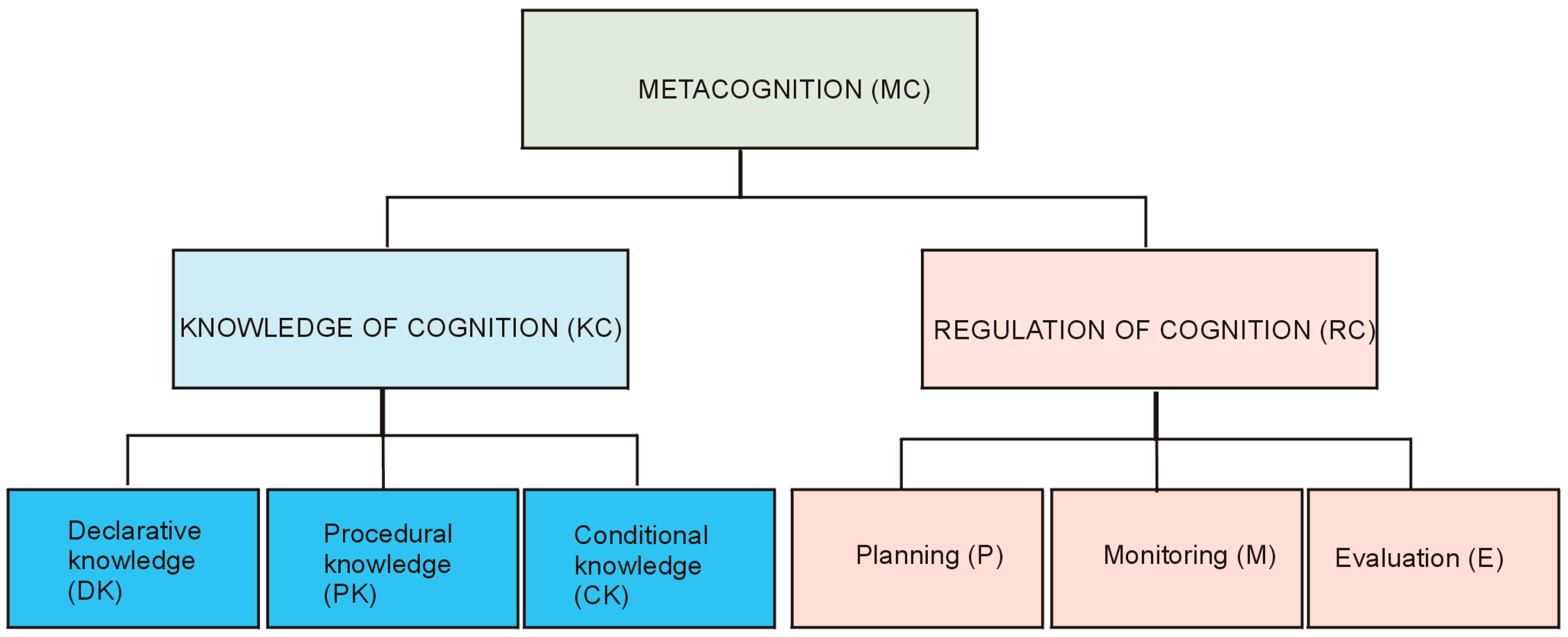
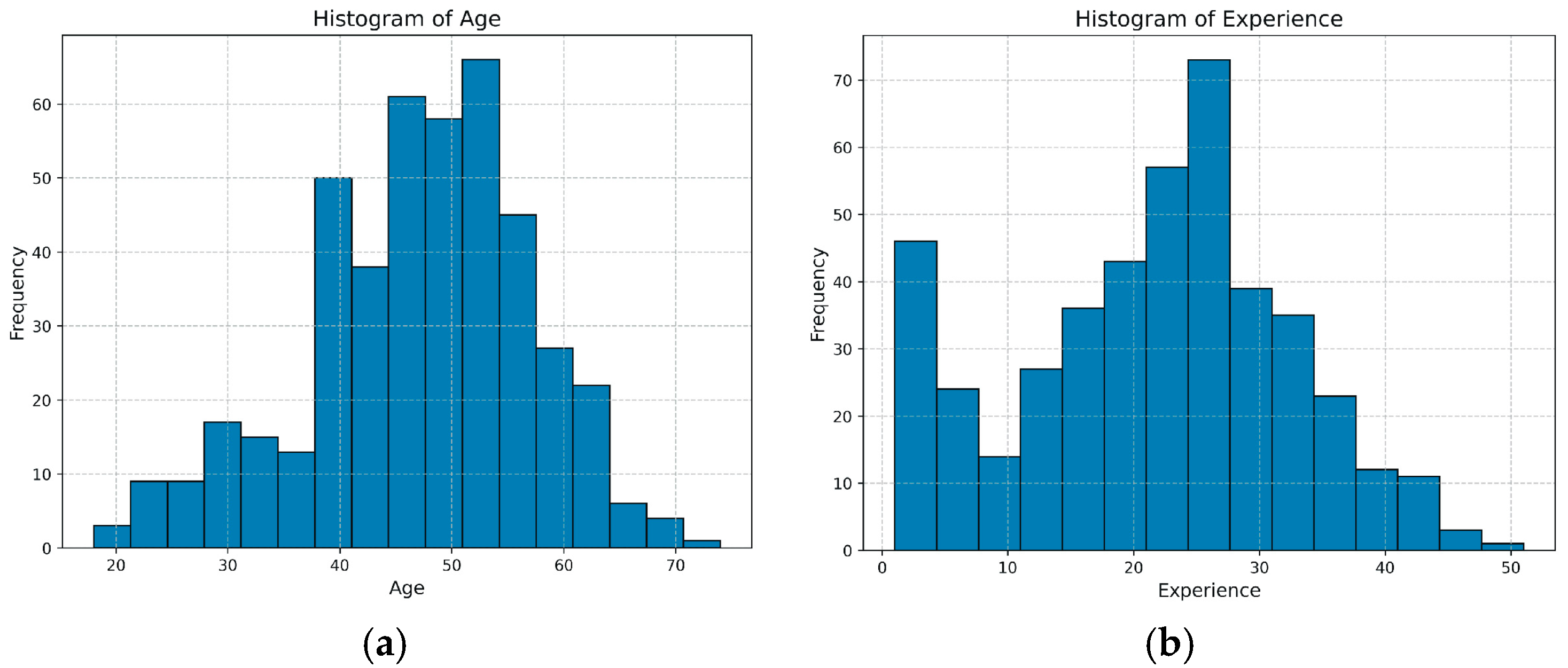
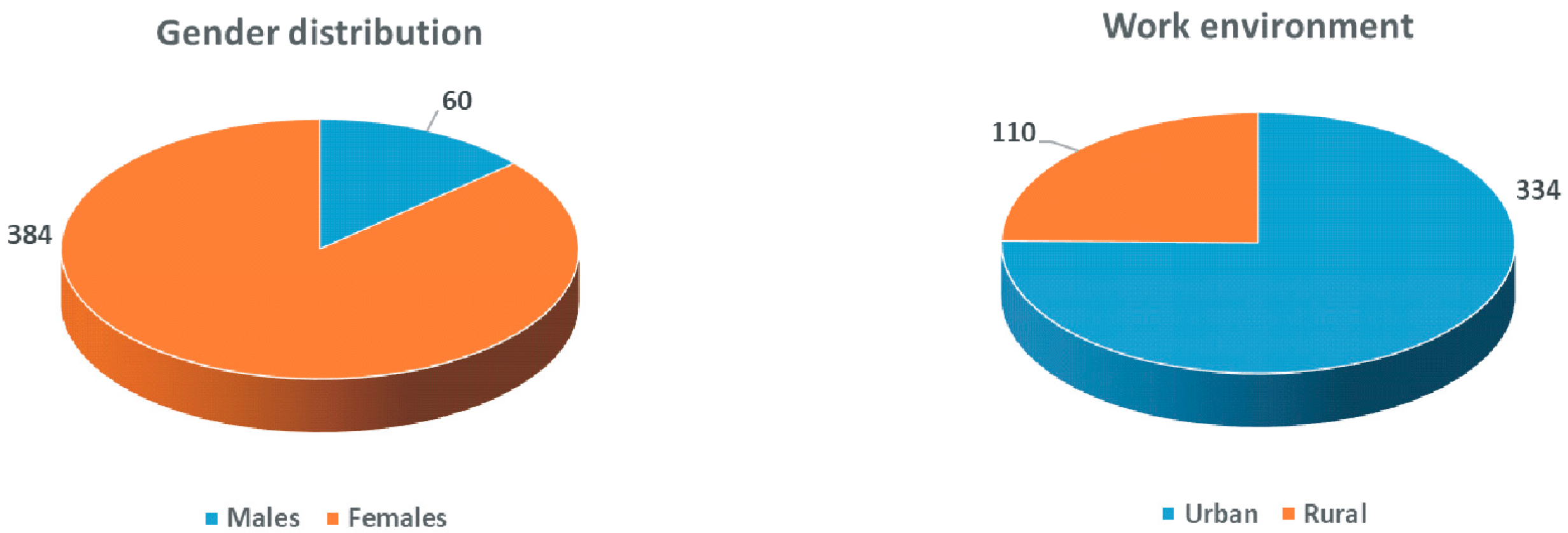
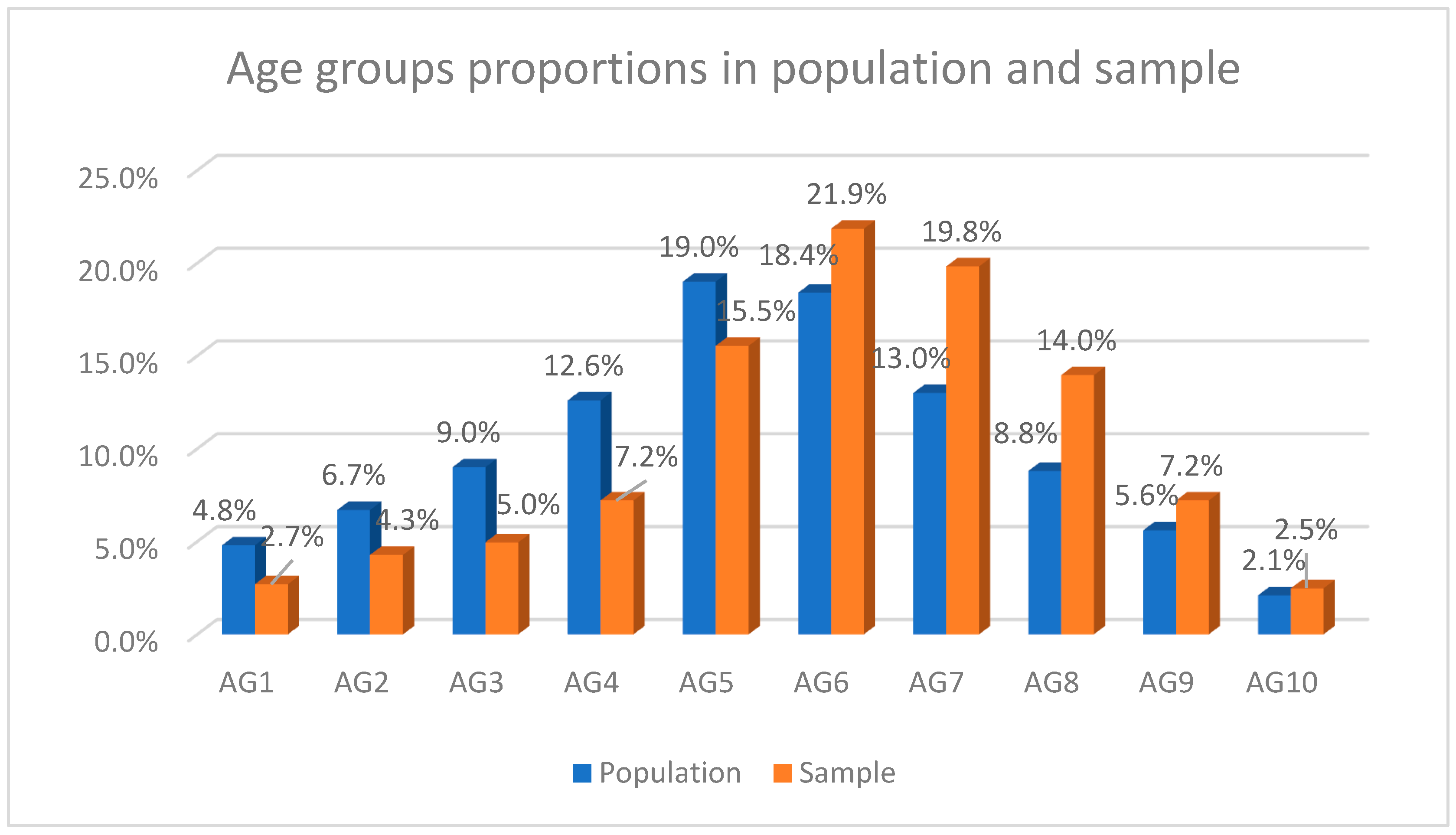

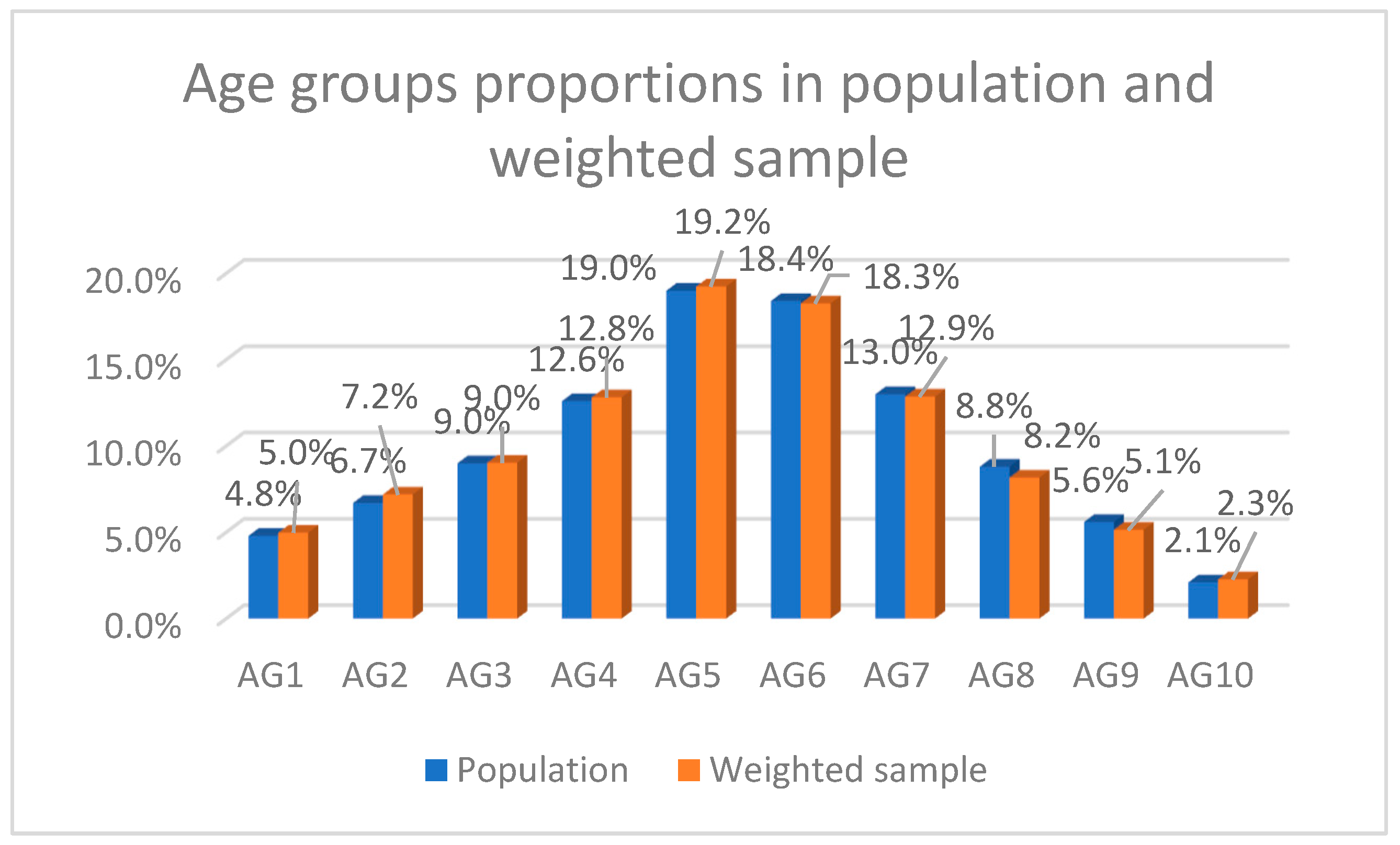
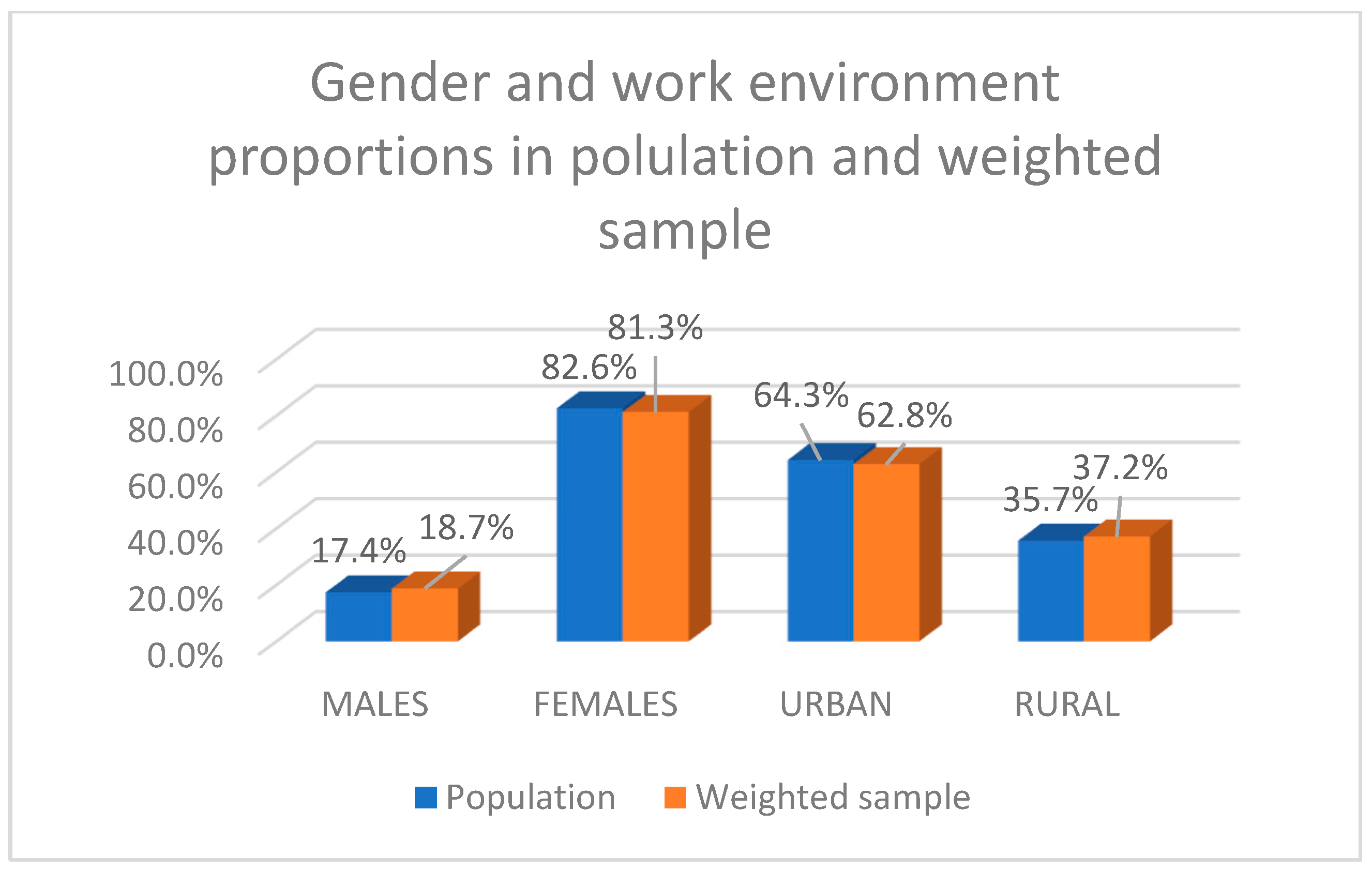
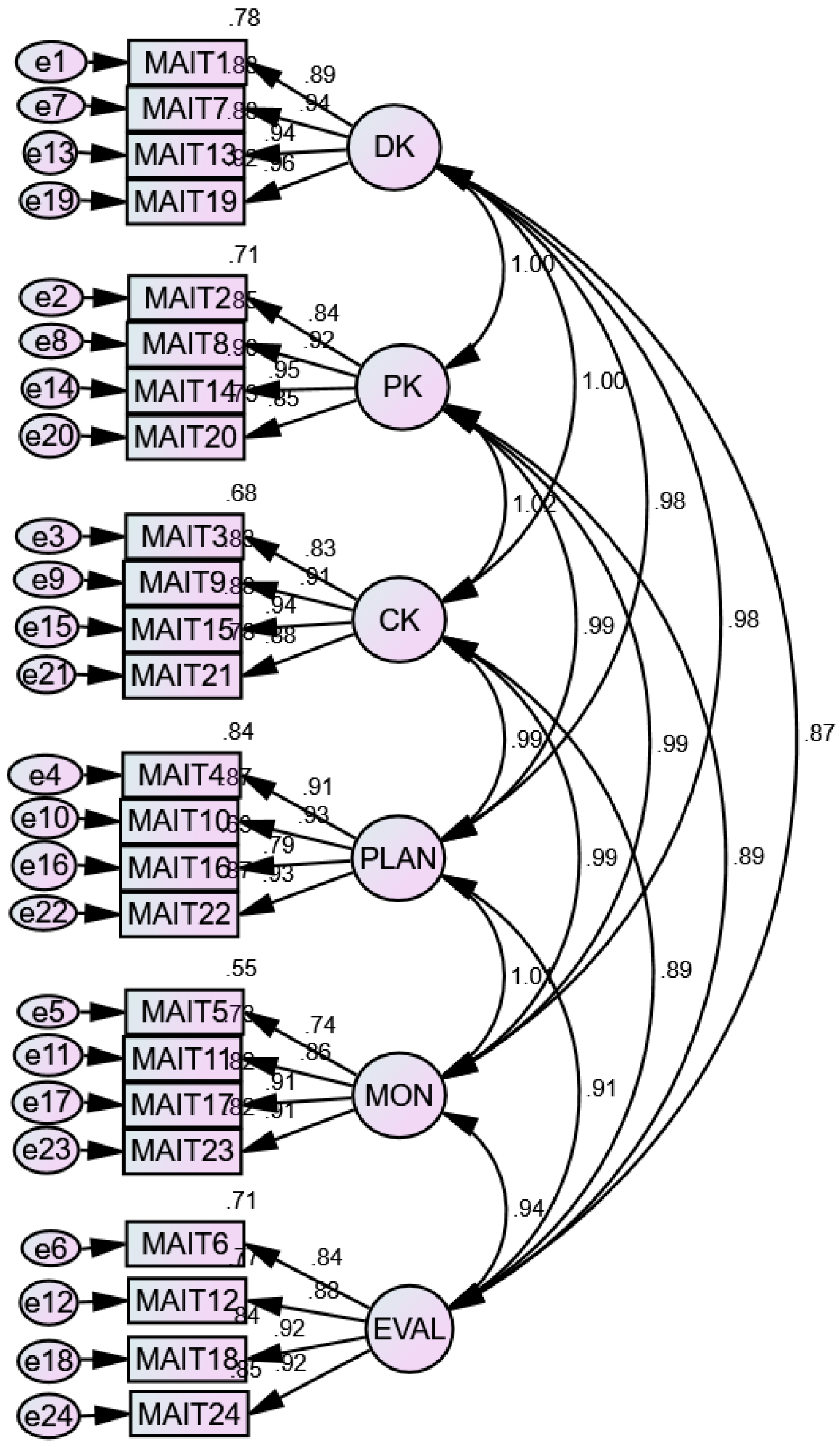

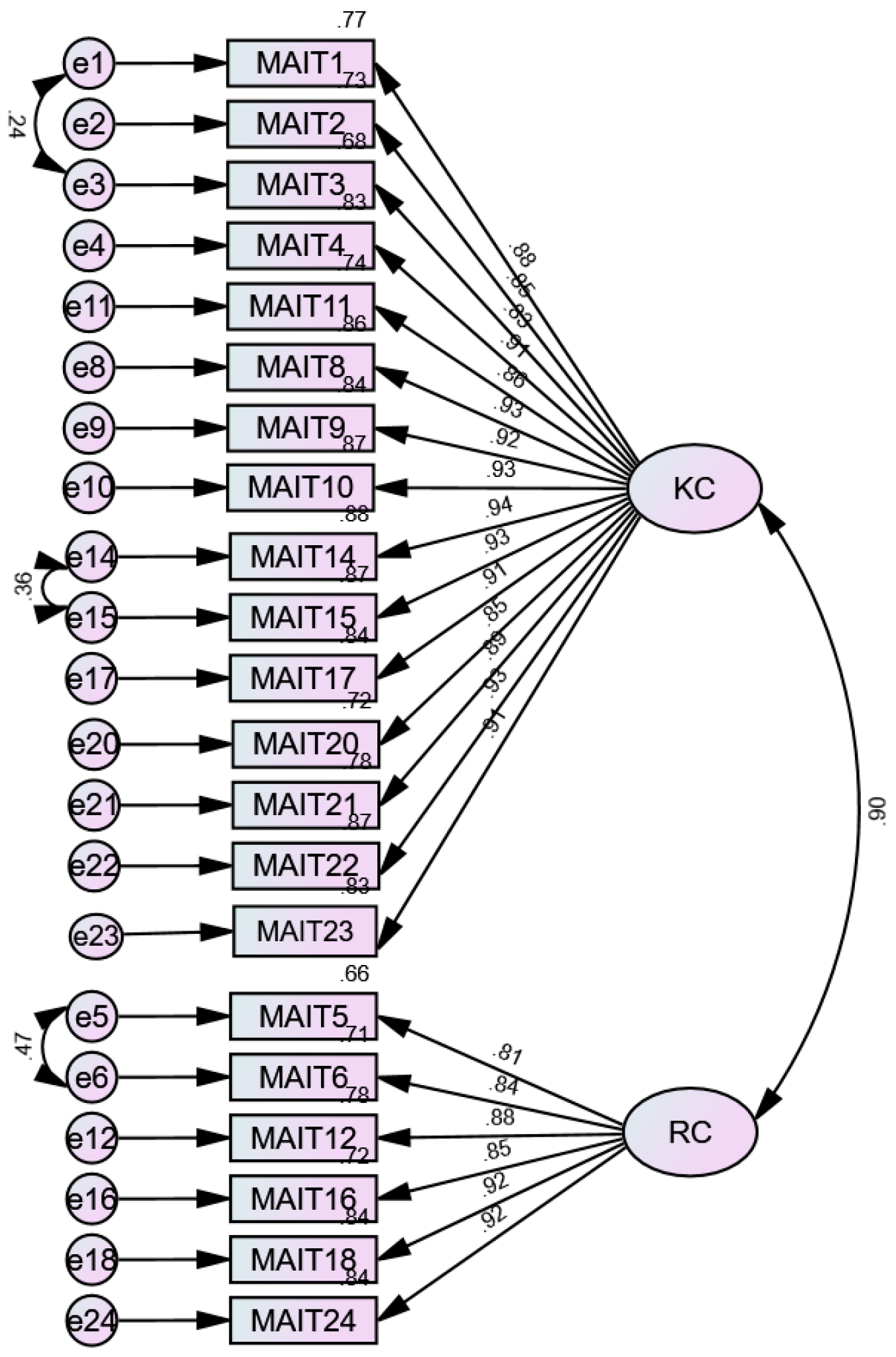
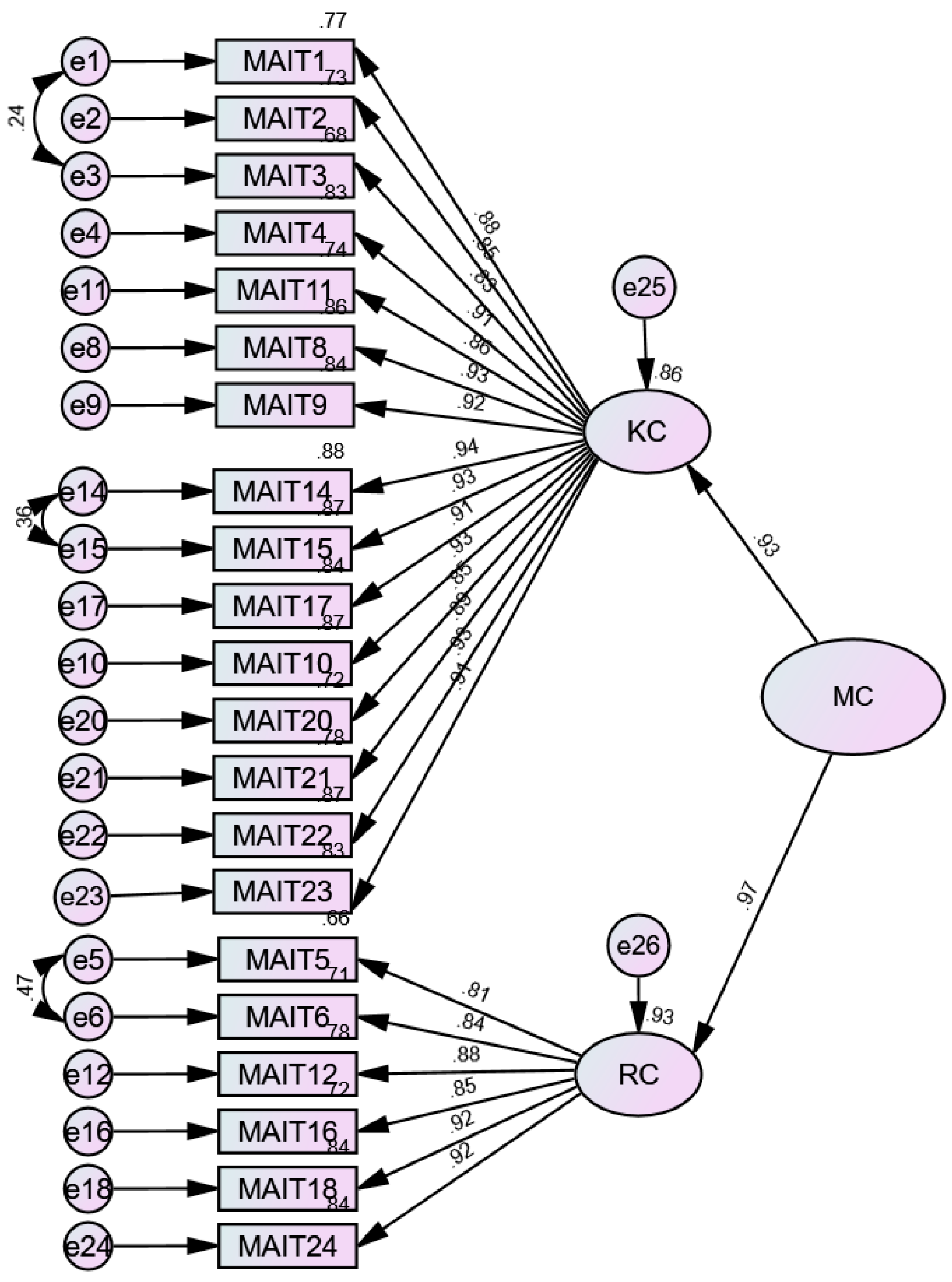
| Index | Description | Threshold |
|---|---|---|
| χ2/df | Chi-square divided by degrees of freedom | ≤3 |
| TLI | Tucker–Lewis index | ≥0.90 |
| CFI | Comparative fit index | ≥0.90 |
| RMSEA | Root Mean Square Error of Approximation | ≤0.06 |
| CR | Composite Reliability score | ≥0.7 |
| AVE | Average Variance Extracted | ≥0.5 |
| Variable | Chi-Square | df | p |
|---|---|---|---|
| Age | 63.184 | 9 | 0.000 |
| Gender | 4.541 | 1 | 0.033 |
| Work environment | 23.525 | 1 | 0.000 |
| Variable | Chi-Square | df | p |
|---|---|---|---|
| Age | 2.611 | 9 | 0.978 |
| Gender | 0.566 | 1 | 0.452 |
| Work environment | 0.353 | 1 | 0.553 |
| M | SD | Skewness | Kurtosis | Correlations | ||||
|---|---|---|---|---|---|---|---|---|
| Declarative knowledge | MAIT1 | MAIT7 | MAIT13 | MAIT19 | ||||
| MAIT1 | 4.32 | 1.27 | 0.88 | 1.56 | 1 | |||
| MAIT7 | 4.34 | 1.25 | 0.87 | 1.50 | 0.834 ** | 1 | ||
| MAIT13 | 4.21 | 1.23 | 1.09 | 2.36 | 0.819 ** | 0.871 ** | 1 | |
| MAIT19 | 4.35 | 1.29 | 1.07 | 1.63 | 0.740 ** | 0.784 ** | 0.800 ** | 1 |
| Procedural knowledge | MAIT2 | MAIT8 | MAIT14 | MAIT20 | ||||
| MAIT2 | 4.10 | 1.34 | 0.75 | 0.88 | 1 | |||
| MAIT8 | 4.26 | 1.28 | 0.93 | 1.55 | 0.808 ** | 1 | ||
| MAIT14 | 4.27 | 1.24 | 0.91 | 1.38 | 0.803 ** | 0.880 ** | 1 | |
| MAIT20 | 3.99 | 1.35 | 0.68 | 0.84 | 0.715 ** | 0.762 ** | 0.792 ** | 1 |
| Conditional knowledge | MAIT3 | MAIT9 | MAIT15 | MAIT21 | ||||
| MAIT3 | 4.09 | 1.31 | 0.86 | 1.35 | 1 | |||
| MAIT9 | 4.21 | 1.25 | 0.96 | 1.49 | 0.765 ** | 1 | ||
| MAIT15 | 4.29 | 1.25 | 0.78 | 0.94 | 0.794 ** | 0.857 ** | 1 | |
| MAIT21 | 3.96 | 1.31 | 1.03 | 1.64 | 0.728 ** | 0.814 ** | 0.812 ** | 1 |
| Planning | MAIT4 | MAIT10 | MAIT16 | MAIT22 | ||||
| MAIT4 | 4.23 | 1.26 | 0.91 | 1.48 | 1 | |||
| MAIT10 | 4.18 | 1.28 | 0.83 | 0.87 | 0.857 ** | 1 | ||
| MAIT16 | 4.04 | 1.38 | 0.84 | 1.19 | 0.684 ** | 0.728 ** | 1 | |
| MAIT22 | 4.15 | 1.22 | 0.85 | 1.03 | 0.872** | 0.872 ** | 0.715 ** | 1 |
| Monitoring | MAIT5 | MAIT11 | MAIT17 | MAIT23 | ||||
| MAIT5 | 3.73 | 1.32 | 0.65 | 0.78 | 1 | |||
| MAIT11 | 4.08 | 1.24 | 0.63 | 0.64 | 0.670 ** | 1 | ||
| MAIT17 | 4.34 | 1.26 | 0.76 | 0.87 | 0.617 ** | 0.779 ** | 1 | |
| MAIT23 | 4.05 | 1.26 | 0.88 | 1.05 | 0.660 ** | 0.787 ** | 0.829 ** | 1 |
| Evaluating | MAIT6 | MAIT12 | MAIT18 | MAIT24 | ||||
| MAIT6 | 3.94 | 1.30 | 0.90 | 1.42 | 1 | |||
| MAIT12 | 3.87 | 1.32 | 0.90 | 1.46 | 0.758 ** | 1 | ||
| MAIT18 | 4.09 | 1.30 | 0.82 | 1.15 | 0.761 ** | 0.825 ** | 1 | |
| MAIT24 | 4.01 | 1.28 | 0.80 | 1.06 | 0.781 ** | 0.799 ** | 0.842 ** | 1 |
| Valid N (listwise) | 444 | |||||||
| Study | Country | Sample Size | Model Structure | Number of Items |
|---|---|---|---|---|
| (Kallio et al., 2017) | Finland | N = 208 | 6-factor, first order | 18 |
| (Parsons, 2019) | U.S.A. | N = 282 | 2-factor, bifactorial | 13 |
| (Gutierrez De Blume & Montoya Londoño, 2020) | Colombia | N = 755 | 6-factor, third order | 21 |
Disclaimer/Publisher’s Note: The statements, opinions and data contained in all publications are solely those of the individual author(s) and contributor(s) and not of MDPI and/or the editor(s). MDPI and/or the editor(s) disclaim responsibility for any injury to people or property resulting from any ideas, methods, instructions or products referred to in the content. |
© 2025 by the authors. Licensee MDPI, Basel, Switzerland. This article is an open access article distributed under the terms and conditions of the Creative Commons Attribution (CC BY) license (https://creativecommons.org/licenses/by/4.0/).
Share and Cite
Susnea, S.; Cretu, C.M.; Lomos, C.; Susnea, I. Adaptation and Psychometric Properties of a Romanian Version of Metacognitive Awareness Inventory for Teachers (RoMAIT). Educ. Sci. 2025, 15, 583. https://doi.org/10.3390/educsci15050583
Susnea S, Cretu CM, Lomos C, Susnea I. Adaptation and Psychometric Properties of a Romanian Version of Metacognitive Awareness Inventory for Teachers (RoMAIT). Education Sciences. 2025; 15(5):583. https://doi.org/10.3390/educsci15050583
Chicago/Turabian StyleSusnea, Simona, Carmen Mihaela Cretu, Cătălina Lomos, and Ioan Susnea. 2025. "Adaptation and Psychometric Properties of a Romanian Version of Metacognitive Awareness Inventory for Teachers (RoMAIT)" Education Sciences 15, no. 5: 583. https://doi.org/10.3390/educsci15050583
APA StyleSusnea, S., Cretu, C. M., Lomos, C., & Susnea, I. (2025). Adaptation and Psychometric Properties of a Romanian Version of Metacognitive Awareness Inventory for Teachers (RoMAIT). Education Sciences, 15(5), 583. https://doi.org/10.3390/educsci15050583






